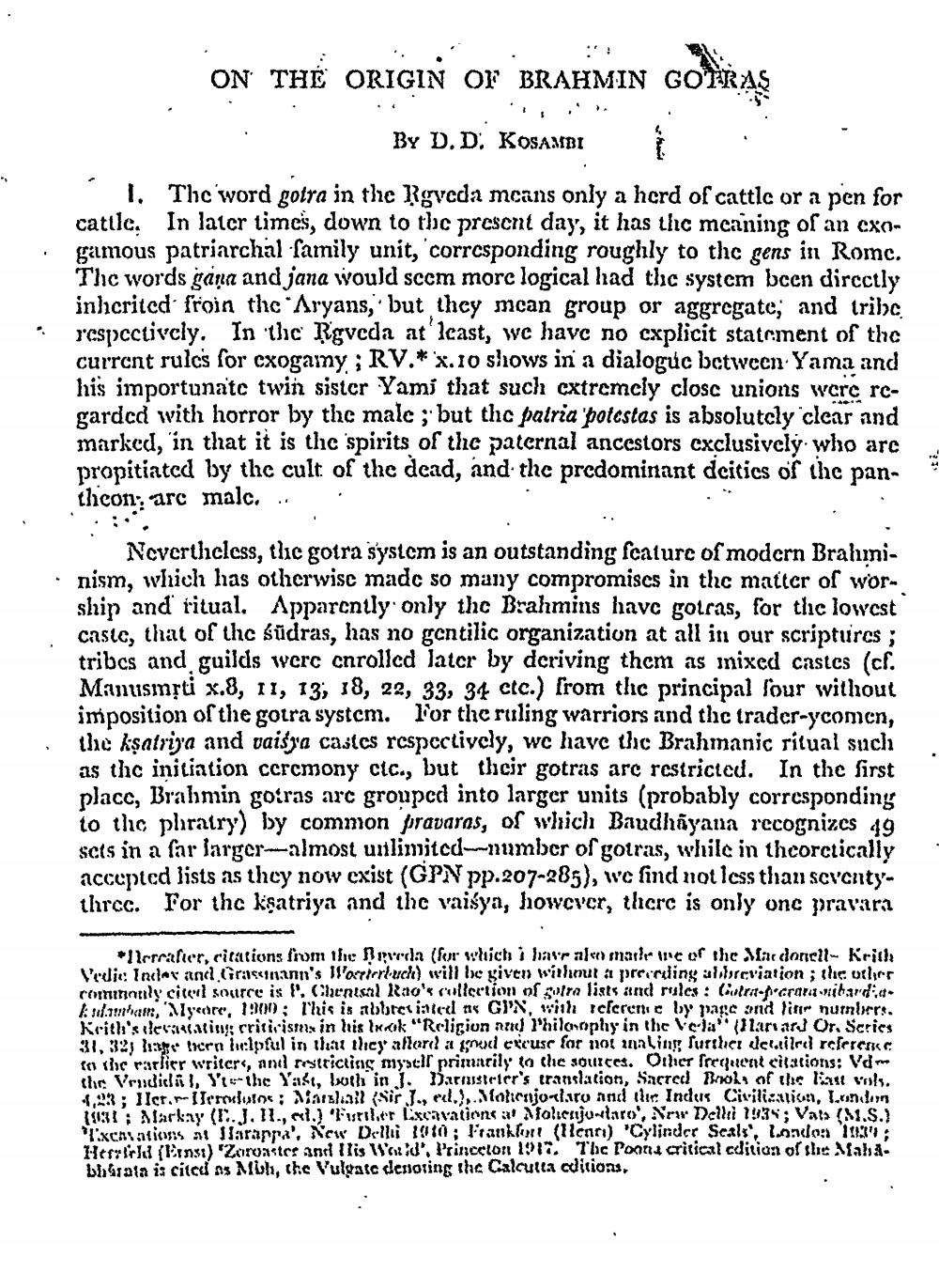Book Title: Origin of Brahmin Gotras Author(s): Dharmanand Kosambi Publisher: D D Kosambi View full book textPage 1
________________ ON THÉ ORIGIN OF BRAHMIN GOTRAS BY D. D. KOSAMBI 1. The word gotra in the Rgveda means only a herd of cattlc or a pen for catulo. In later times, down to the present day, it has thc meaning of an exogamous patriarchal family unit, corresponding roughly to the gens in Romc. Thc words gana and jana would sccm morc logical had thic system been dircctly inherited froin thc Aryans, but they mcan group or aggregate, and tribc. l'espectively. In the Rgvcda at' lcast, we have no cxplicit statement of the current rules for cxogamy; RV.* *.10 shows in a dialoguc between Yama and his importunate twin sister Yami that such cxtrcmcly closc unions were rcgarded with horror by the male ; but thc patria potestas is absolutely clear and at it is thic spirits of the paternal ancestors cxclusively who are propitiated by the cult of the dead, and the predominant dcitics of the pan. thcon: arc malc.. Nevertheless, tlic gotra system is an outstanding featurc of modern Brahmi· nism, which has otherwise made so many compromises in the matter of wor ship and ritual. Apparently only thc Brahmins have golras, for the lowest caste, that of thc sūdras, has no gentilic organization at all in our scriptures ; tribcs and guilds wcrc cnrollcd later by dcriving them as inixed castcs (cf. Minusmrti x.8, 11, 13, 18, 22, 33, 34 ctc.) from thc principal lour without imposition of the golra system. For the ruling warriors and thc tradcr-ycomen, the ksatriya and vaisya castes respectively, we have thic Brahmanic ritual such as thic initiation ceremony cic., but their gotras arc restricted. In the first place, Brahmin goiras arc grouped into larger units (probably corresponding to tlic pliratry) ly common pravaras, of which Baudhayana recognizes 49 scts in a far larger-almost unlimitedm-umber of gotras, while in theorctically accepted lists as they now exist (GPN pp. 207-285), we find not less than scvcnitythrcc. For thc ksatriya and the vaisya, however, there is only onc pravara Ilrrrafier, citations from the novela (for which i have also marle ire of the Macdonell- Kritha Velic Inday and Grassinann's Il'oxrirrkuch) will be given without a preceding alworcviation : the ullir commonly citer source is ', Chenisa Rao's collection of guira lists and rules : Cutrit-pcrara nibardia wawhai yedre, 1900): This is athbretiated GIX, with referente by pare and lite nurrrs. Krith's cle aring criticism in his lx.ck "Religion and l'hilosophy in the Vela (31anard Or. Scrics 31, 32, 3 tcrn lclpful in that thicy allord a good excuse for not inaling further detailre rcfercise in the rarlier writers, and restricting myseir primarily to the sources. Other frequent citations: Vd the Vrndilal, Yt the Yalt, both in ). Darustrier's translation, Sacred Bhols of the last vols. 4,23; llct. Iteruluro : Warsall (Sir J., ed.). No enjo-laro and the Indus Civilization, Londen 14031 : Mariny (I.J.11., l.) 'Furiler Lxcavations al folicujo-laro', New Delhi 1934; Vata (M.S. #lixchiations at Sarappa, New Delhi 1910; Frankfort (llcnri) 'Cylinder Scals, London 103" Herria (Eins) "Zoroaster and tlis Word', Princeton 1917. The Poon critical cdition of the Maha. bhraia ia cited as Muh, the Vulgarc denoting the Calcutta editions,Page Navigation
1 2 3 4 5 6 7 8 9 10 11 12 ... 59
